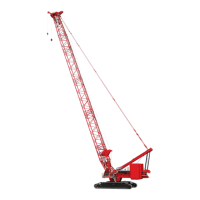HOISTS MLC80A-1/MLC90A-1/MLC100A-1/MLC100-1 SERVICE/MAINTENANCE MANUAL
5-34
Published 10-09-2020, Control # 259-06
- Power line contact
• Exposure to abuse and shock loads, such as:
- High-velocity movement, such as hoisting or
swinging a load followed by abrupt stops
- Suspending loads while traveling over irregular
surfaces such as railroad tracks, potholes, and
rough terrain
- Moving a load that is beyond the rated capacity of
the lifting mechanism (overloading)
NOTE: Inspection intervals may also be predetermined by
state and local regulatory agencies.
Replacement Criteria
Deciding when a wire rope should be replaced is the
responsibility of the qualified person who is appointed to
review rope inspection records and evaluate rope condition.
The following are indications that the rope needs to be
replaced:
• Reduction in the rope diameter and excessive broken
wires (see Reduction in the Rope Diameter on page 5-
34 and Broken Rope Wires on page 5-34)
• Wear of one-third of the original diameter of outside
individual wires
• Kinking, crushing, birdcaging, or any other damage
resulting in distortion of the rope structure
• Evidence of any heat damage from any cause
• Severe corrosion as evidenced by pitting
• Independent wire rope core (IWRC) or strand core
protrusion between outer strands
• Obvious damage existing from any heat source
including—but not limited to—welding, power line strike,
or lightning
Reduction in the Rope Diameter
A reduction in rope diameter is often the first outward sign
that the rope core is damaged. Reduction in the rope
diameter can be caused by loss of core support, internal or
external corrosion, or wear of the outside wires.
New Wire Rope—After initial loading, measure and record
the diameter of any new wire rope for comparison to future
inspections (see Maintain a Wire Rope Condition Report on
page 5-31).
The wire rope must be taken out of service when the
reduction from its nominal diameter is more than 5 percent.
Broken Rope Wires
When conducting the periodic comprehensive inspection,
thoroughly clean the wire rope so breaks can be seen. Relax
the rope, move it off “pick-up points,” and flex it as much as
possible to uncover damage. Use a sharp awl to lift any wire
which appears loose. Do not attempt to open the rope.
Wire breaks are typically at the crown of the strands—the
area that contacts the sheave or drum when a load is picked
up. Breaks at the crown will appear as small gaps in a wire.
In comparison, when wires in the valley of a strand break, the
broken ends will rise up and are easier to notice.
NOTE: The daily inspection does not require that the rope
be cleaned or probed.
The wire rope must be taken out of service when it has the
following number of broken wires (see Figure 5-24
for an
explanation of lay length):
• Running Ropes—Six randomly broken wires in one lay
length or three broken wires in one strand in one lay
length.
• Standing Ropes (pendants)—More than two broken
wires in one lay length in sections beyond the end
attachment, or more than one broken wire at the end
attachment (see Figure 5-23
).
• Rotation-resistant rope—Two randomly distributed
broken wires in six-rope diameters or four randomly
distributed broken wires in 30-rope diameters.
WARNING
Falling Load Hazard!
A broken wire indicates a weakened wire rope. Replace
wire rope when more than one broken wire appears.
Incorrect
Correct
Measuring Technique
FIGURE 5-22

